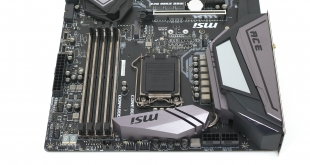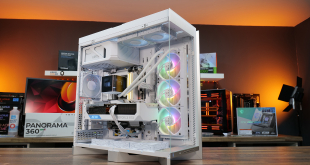
Intel's Z390 platform continues to be a firm favourite with the DIY enthusiast audience, in large part because of the excellent performance delivered by the Core i9 9900K. That processor, however, is more power-hungry than its predecessors and motherboard vendors have necessarily responded with higher-end power circuitry. MSI's Enthusiast Gaming (MEG) ACE motherboard crystallises this approach with 12 phases purely aimed at powering all eight cores with overclocking.

The MSI MEG Z390 ACE is designed to be a high-end performer loaded with connectivity and features, leading MSI to make bold design decisions. One of those is completely doing away with the integrated graphics to maximise board space for connectivity and CPU VRMs; things MSI believes the overclocking audience demands.
MSI hasn't just got tunnel vision on VRMs though, MSI has gone all out on connectivity with a hefty eight USB 3.1 10Gbps ports, three M.2 slots, four RGB headers and both wired and wireless networking solutions. Troubleshooting and overclocking features have been implemented generously as well: a clear CMOS button, onboard diagnostic LEDs, debug code reader, BIOS flashback and VRM monitoring sensors all come included.
MSI has managed all of the above while still coming to market at a lower or similar price point to many of its rivals. On paper at least, MSI looks to have pulled it off, but let's find out how the MEG Z390 ACE stands up to scrutiny.
| MSI MEG Z390 ACE | |
| Form Factor | ATX, 24.4cm x 30.5cm |
| CPU Socket | Intel LGA 1151 v2 |
| CPU VRM PWM |
Infineon International Rectifier IR35201 in 6+1 actual phase operational mode, 12+1 virtual phase mode 6 x Infineon International Rectifier IR3598 phase doublers |
| CPU VRM MOSFETs |
12 x ON Semiconductor NTMFS4C029N (high-side) and 12 x On Semiconductor NTMFS4C024N (low-side) |
| Chipset | Intel Z390 |
| Memory | DDR4, 4 DIMMs, up to 64GB, up to 4500MHz+ with OC |
| On-board Graphics | Not supported (no display outputs or iGPU VRM) |
| Discrete Graphics | Nvidia 2-Way SLI or AMD 3-Way CrossFire |
| Expansion Slots | 3 x PCIe 3.0 X16 (from CPU, 16x/0x/0x, 8x/8x/0x or 8x/4x/4x) 3 x PCIe 3.0 X1 (from PCH) |
| Storage | 2 x M.2 SATA III 6Gbps or PCIe 3.0 X4* 1 x M.2 PCIe 3.0 X4 only* 6 x SATA III* *Bandwidth sharing between SATA and M.2 ports |
| USB | 8 x USB 2.0 (4 Rear, 4 Front, from PCH) 4 x USB 3.0 (4 Front, from ASM1042) 8 x USB 3.1 10Gbps (4 Rear Type-A, 2 Front Type-C from PCH, 1 Rear Type-A and 1 Rear Type-C from ASM3142) |
| Networking | 1 x Killer E2500 Gigabit Ethernet Intel Wireless-AC 9560 |
| Audio | Realtek ALC1220 7.1 channel HD audio with ESS Sabre 9018 32-bit Digital to Analogue Converter (DAC) |
| RGB | 1 onboard RGB lighting zone (rear I/O) 2 x 12v G R B 1 x 5v Digital Addressable 1 x Corsair-specific 5v Digital Addressable |
| Fan Headers | 7, all support 3/4pin (1 x CPU, 1 x PUMP, 5 x SYS) |
| Rear I/O |
Clear CMOS Button
4 x USB 2.0 Ports 1 x Killer E2500 Gigabit LAN 2 x Wi-Fi /Bluetooth Antenna Connectors 5 x HD Audio Connectors BIOS FLASHBACK+ Button 6 x USB 3.1 Gen2 Ports Type A+C 1 x Optical S/PDIF-Out |
| UEFI | AMI compliant |
 KitGuru KitGuru.net – Tech News | Hardware News | Hardware Reviews | IOS | Mobile | Gaming | Graphics Cards
KitGuru KitGuru.net – Tech News | Hardware News | Hardware Reviews | IOS | Mobile | Gaming | Graphics Cards


